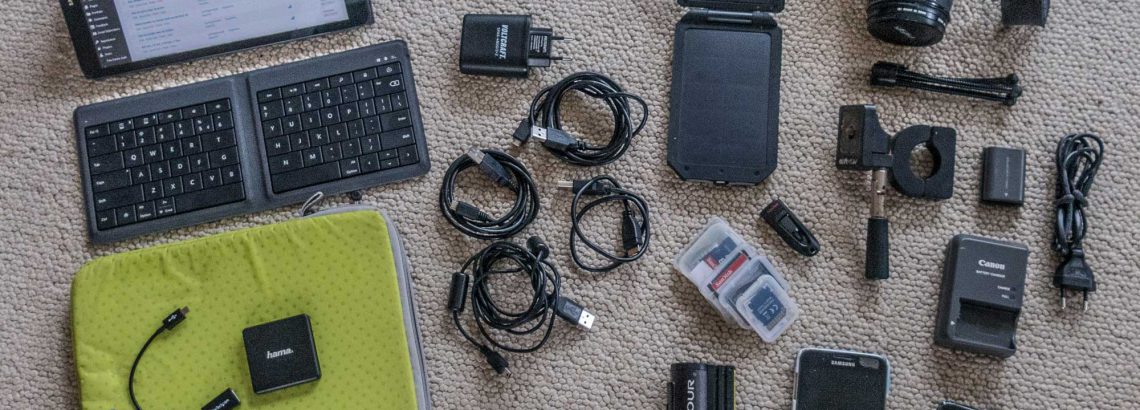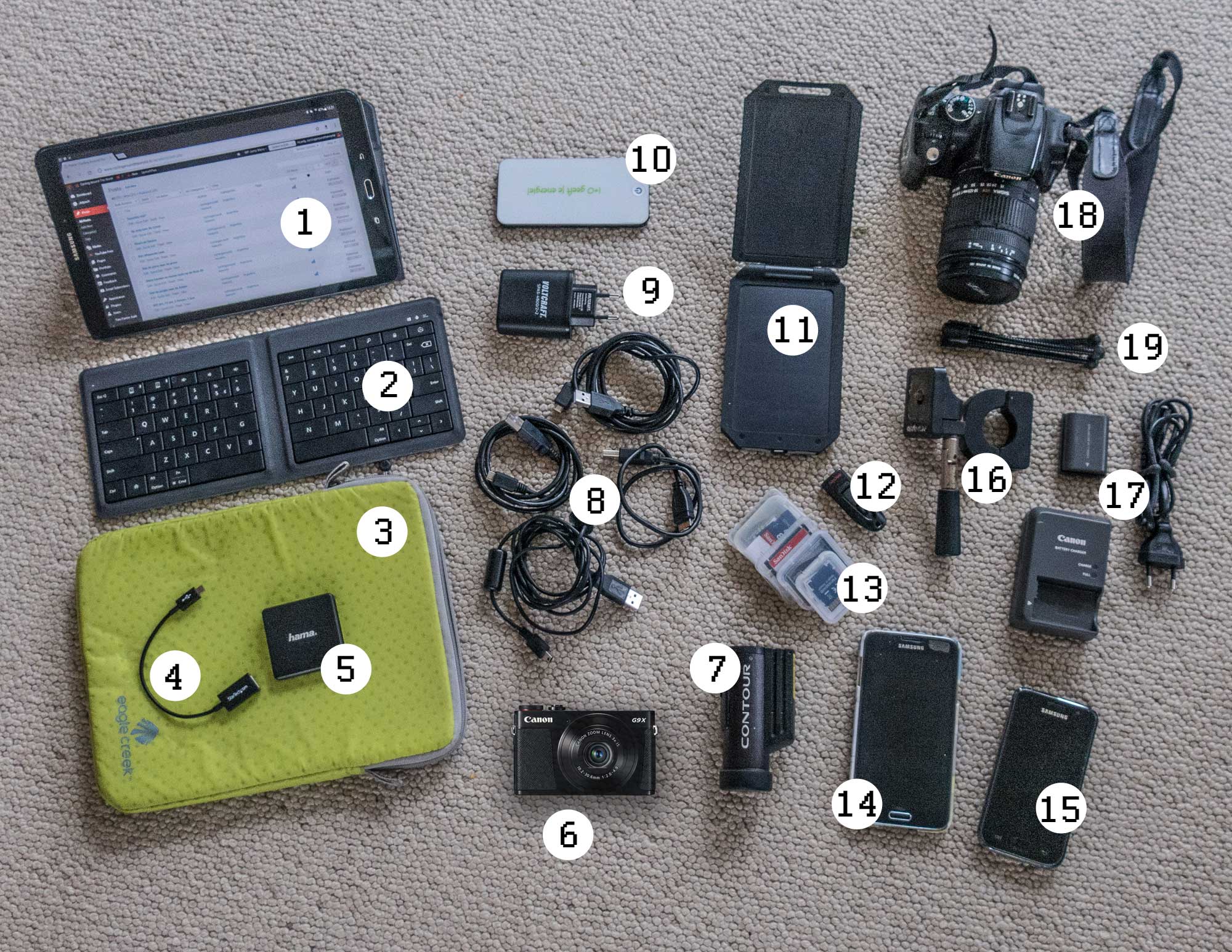In 2017 we started sharing their experiences by blogging while travelling. This required a whole new setup of devices, battery chargers and cables. This page describes what we used to create blogposts during our trip through Argentina and Paraguay.
Writing blogposts, editing video clips and photos proved to be a part time job ;-). Producing a full blog post with text, photos and a short Youtube video clip generally took one of us a significant part of a day.
One word of advice: try newly installed hardware and software extensively before you set out on a trip. We started blogging in the spring of 2017 during our Andalucia trip and discovered that some hardware and software setups just aren’t very practical.
The hardware
On the picture below the full setup of stuff we used to create blog posts.
1. Samsung A6 2016 Tablet with Samsung Book Cover 2. Microsoft Universal Foldable Keyboard 3. Sturdy cover for keyboard en tablet 4. USB OTG cable 5. Cardreader for SD and CF 6. Canon G9X compactcamera 7. Contour Roam2 action camera 8. too many USB cables 😉 9. Charger with 4 USB ports 10. Powerbank 11. Xtorm Solar Powerbank 12. 64 Gb USB stick extra storage 13. Many SD and CF cards 14. Samsung S5 smartpone 15. Samsung A6 dual sim smartphone 16. Bicycle tripod Airbone 17. Spare battery + charger + cable for the 350D 18. Canon 350D camera. 19. Mini tripod
The software
- Filmorago for video editing
- Adobe Photoshop Express photo editor
- WordPress
- Youtube app for uploading video
Blogging
This website runs on WordPress which is also great for blogging. You only need a stable WIFI connection. Anja keeps a diary every day that could be used as a source to write the blog text. We generally wrote at least one post every two weeks.
As we were using an Android tablet for most of the writing and editing we needed a good keyboard. After trying some we ended up with the Microsoft Foldable keyboard. Not cheap but very compact and reliable. It runs for weeks and weeks without being charged.
Email service
As a service to our readers we offer the possibility to subscribe to new blogposts.
Update 2019: As the number of subscribers was growing we kept having technical issues when sending our periodical newsletter. So in 2019 we moved to Mailchimp. Maichimp not only handles the subcriptions but also offers extensive possibilities for styling your newsletter/ Mailchimp’s Forever Free Plan gives you access to most Mailchimp features, but limits your total subscribers, as well as your daily and weekly sends. Keep up to 2,000 subscribers in your account, and send up to 12,000 emails per month. In any 24-hour period, you can send up to 2,000 emails.
Photography
On a nice day we take up to 50 photos with the two cameras. Incidentally we also take pictures with our smartphones. We are using the RAW format for the cameras. The major advantage is the high quality (also after editing) the disadvantage the larger file size and the fact that not all editors can handle this RAW format.
The Adobe Photoshop Express app for Android was the perfect editor. Every possible edit can be applied and the result exported as a much smaller (in dimensions and size) JPG photo. Ideal for uploading over slower connections.
To connect a camera or card reader to another ‘mobile’ device such as our tablet you’ll need an USB On The Go (OTG) cable. This sets up a data connection enabling us to copy photos and video clips from the cameras to the tablet for further editing and uploading.
Video
Finding a suitable video editor for our Android tablet wasn’t easy. There are many apps most of them not very good. We ended up using Filmorago. No ads and no watermark. Just the Filmorago logo added at the end. Filmorago has all basic editing functions but is not very good in handling larger (e.g. 30 minutes and longer) video clips. The processing time becomes too long.
We created introduction and end clips (the spinning globe) already before we left. We also downloaded free audio from the Youtube Audio Library or from the Free Music Archive.
Charging batteries
We carried a charger with four USB ports but rarely used all four ports. The additional power banks were also rarely used as on our last trip we also stayed in hotels etc. where plenty of power plugs are available. Note: some countries have different systems for power plugs; bring an adapter.
This is a lot of stuff!
This is a lot of stuff, can I do the same with less? Yes you can :-). Making and editing videos and photos, writing text and publishing it on a blog could all be done with a single smartphone perhaps with an additional keyboard. For our future trips we will certainly reconsider the current setup of hardware. This article will be updated :-).


